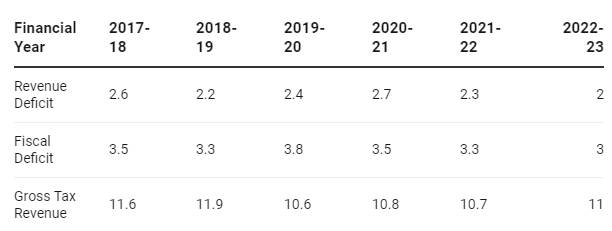The government has projected a fiscal deficit of 3.5% of GDP for the fiscal year 2020-21 against 3.8% for the fiscal year 2019-20. The absolute level of fiscal deficit is Rs 7963.37 billion against Rs 7668.46 billion, a growth of 3.85%. Growth in nominal GDP is pegged at 10.0% by the government.
The fiscal deficit is normally financed largely by market borrowings through issue of dated government securities. Market borrowings financed 92%, 87%, 83%, 80%, 80.7% 66.64% and 61.81% of the fiscal deficit in 2014, 2015, 2016, 2017, 2018 2019 and 2020 respectively, Budgeted market borrowing for Fiscal 2020-21 is Rs 5358 billion. Correspondingly, gross borrowing is budgeted at Rs 8100 (Including Buyback). The government has Budgeted for bond switches and bond buyback for Rs 2700 billion and Rs 300 billion each in fiscal 2020-21.
The government has shown a net market borrowing of Rs 5448 billion to finance the fiscal deficit of Rs 7963 billion, which is 69.86% of the fiscal deficit. The market borrowing to finance the deficit will increase by 14% from the previous year’s revised level.
The increase in inflows into the NSSF (National Small Savings Fund) has changed the borrowing dynamics. The government has also discontinued investments of NSSF receipts into state government securities and all investments are made in central government securities.NSSF inflows were budgeted at Rs 750 billion for fiscal 2018-19, which were revised to Rs 1250 billion and for fiscal 2019-20, the government had budgeted for Rs 1300 billion which was revised to Rs 2400 billion and for Fiscal 2020-21, its budgeted at Rs 2400 billion.
The government is pegging the gross borrowing at Rs 7800 billion. Bond redemptions for 2020-21 are at Rs 2470 billion.
Sources of Financing Fiscal Deficit
Fiscal Deficit ,Primary and Revenue deficit (Rs billion) - Budget FY20 - July 2019
Deducting gross borrowing of Rs 7800 and redemptions of Rs 2470 billion, net borrowing works out to Rs 5330 billion which is almost similar to government estimates of Rs 5358 billion.Bond buyback and switches of bonds maturing next year explains the government net market borrowings estimate.
Fiscal Deficit, Revenue Deficit and Primary Deficit
Fiscal deficit is the difference between total revenues and total expenditure of the government. Given that the Indian government spends more than it earns it runs a fiscal deficit, which is financed by market borrowings. Government borrowing every year adds to the stock of outstanding debt that is at close to Rs 50 trillion. Given rising government debt, interest cost for the government rises every year (Read our note on Expenditure Budget) that in turn puts pressure on government finances, which in turn leads to fiscal deficit, which again leads to government borrowing and increase in stock of outstanding debt. A classical self-fulfilling cycle.
Fiscal deficit is the difference between total expenditure and total revenue of the government while primary deficit is fiscal deficit less interest costs.
Revenue deficit is the difference between expenditure and revenue on the revenue account. Revenue expenditure does not go into creation of capital assets and hence it is non productive. Effective revenue deficit, which was introduced in 2011-12, reduces from the revenue deficit, government grants to states and other bodies for creation of capital assets.
The government is conscious of the need to bring down levels of fiscal and revenue deficits and has adopted the FRBM (Fiscal Responsibility and Budget Management) Act that sets targets for revenue and fiscal deficit as percentage of GDP. FRBM target for 2018-19 revenue deficit of 2.2%, fiscal deficit of 3.3%. Table 3.
FRBM Targets as % of GDP (Budget 2020-21)




